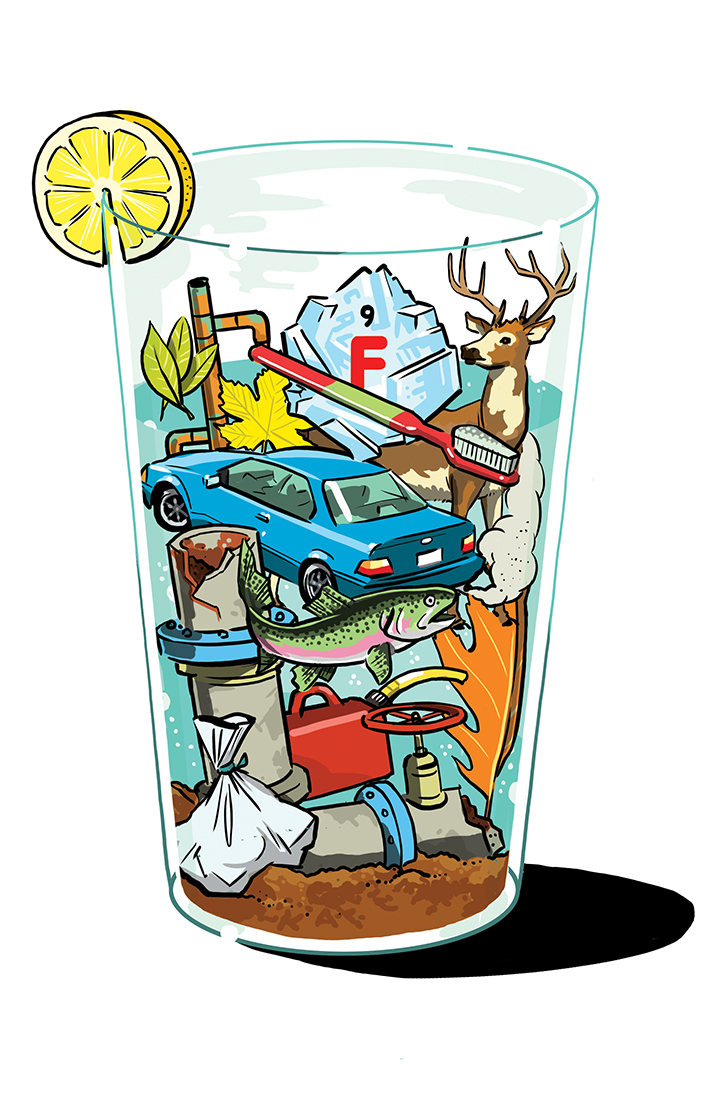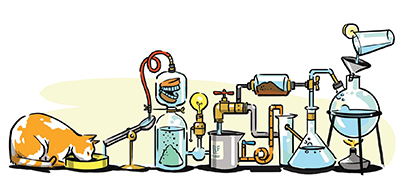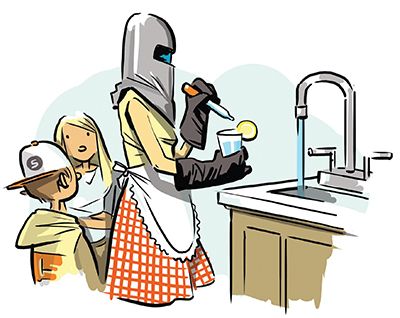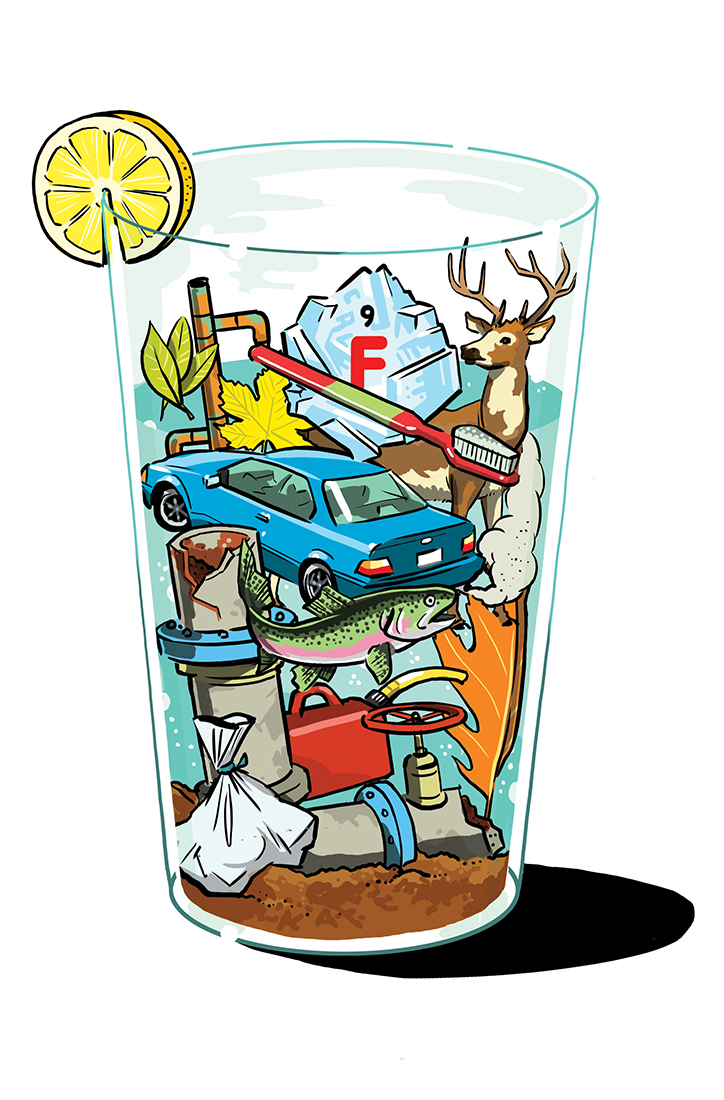
LOOK UP AS you enter Marin Municipal Water District’s Water Quality Laboratory and you’ll see where most of Marin County’s water comes from: Mount Tamalpais. On the day I visited, the peak was wrapped in a fluffy cloud muffler; the autumn’s first storm had just deposited a much-needed contribution to the seven reservoirs up there.
Three-quarters of our drinking water starts out as raindrops on Mount Tam, with the remaining quarter drawn from deep below the Russian River, where it is naturally filtered by 60 feet of sand beds. Not everyone is lucky enough to drink from such pristine sources. I, for instance, grew up drinking from Lake Michigan, near Milwaukee, where in 1993 a protozoan called cryptosporidium sickened 400,000 people.
But just because the liquid in your tap flows from mountain lakes and from far below ground doesn’t mean there’s nothing but H2O in there. Inside MMWD’s Water Quality Lab, three chemists work daily to measure just what is in your water, and how much. They’re ready to take action if anything alarming pops up in the samples continually taken from the reservoirs, water treatment plants, and sampling stations throughout Marin and from customers’ kitchen sinks
“Our lab probably does 2,000 to 2,500 analytical tests per month,” says chemist Chris Nanney. “Forty years ago, the primary function of a water quality lab was to do microbiology, to look at samples for total coliform and E. coli. We still do a lot of that work,” Nanney says: in fact, on a lab counter sits a tray full of plastic vessels the size of newborn baby bottles, holding treated water that just tested negative for those bacteria. “However, there has been a big emphasis shift to chemical analysis,” he adds.
The lab is full of Rube Goldbergian machines, with fine tubes winding around and through them and tall tanks of helium and nitrogen standing by. One machine draws water from amber glass vials the size of medicine bottles to make sure the district’s two processing plants are filtering out enough organic carbons — the product of decaying leaves, dead fish and other yucky stuff found in nature. On another counter hulks an ion chromatograph, used to analyze water samples for fluoride, chloride, phosphate, sulfate and bromide.
You don’t have to tour this lab to find out what’s in Marin’s water and what’s not; the lab puts out an annual report to tell you. Still, here are some of those findings and what you should know about them:
What’s in Your Tap Water
Chloramine
If you fill a one-liter pitcher with tap water in any of the 10 towns and cities or unincorporated areas MMWD serves, it will contain up to 2.5 mg of chloramine, a combination of chlorine and ammonia used to kill viruses and bacteria, such as E. coli. MMWD uses chloramine in addition to chlorine because it lasts longer, an important quality for a water system that is spread out across a greater distance and a wider range of elevations than many systems.
This residual disinfectant is the reason that some people detect a chlorine taste in their tap water; you can remove that taste by using a filter or by letting water sit in the fridge for a while to allow the offending compound to dissipate. Although the Environmental Protection Agency deems chloramine safe for drinking water at levels more than twice the amount found in Marin’s water, some people oppose the use of this disinfectant at any level, such as the Bay Area group Citizens Concerned About Chloramine, whose members believe chloramine can cause health problems like asthma or skin disorders.
Haloacetic Acids and Trihalomethanes
That liter of tap water will also contain up to a few dozen micrograms of these chemicals, which, if consumed above recommended levels for many years, are associated with increased risk of cancer and other health problems. However, Marin Municipal Water District’s product comes in at an average of half the maximum level regulators deem safe.
These compounds are the result of disinfectants — chlorine and chloramines — reacting with organic carbons. The reason MMWD filters out 25 to 35 percent of total organic carbons is to keep these byproducts low.
Reviewing MMWD’s 2015 water report, Natural Resources Defense Council senior attorney Mae Wu saw no cause for alarm in Marin’s levels of disinfectants or disinfectant byproducts. “While there may be some potential health concerns with them, it’s nothing compared to everybody dying of dysentery,” she says.
Fluoride

Every time San Rafael resident Mary Larkin turns on her kitchen tap to get a drink of water, the liquid flows through a two-tower reverse-osmosis filter sitting on her countertop. Then she squeezes an eyedropper full of supplements into the water to put back some of the healthy minerals this filter removes. Larkin goes through this cumbersome and expensive process because she believes that the fluoride in Marin’s water is hazardous to her family’s health.
She’s not alone. Of all the ingredients in Marin water, the added fluoride — .7 mg per liter, recently decreased from .9 mg due to a regulatory change — is the most controversial. In fact, local group Clean Water Sonoma-Marin is collecting signatures for a proposed 2016 ballot measure to put a moratorium on fluoridation. Marin residents voted in 1972 and 1978 to fluoridate the water, and a 1995 California law requires it for systems of Marin’s size. Because of that state law, it’s not clear if fluoridation would stop even if the moratorium were to pass.
The Centers for Disease Control trumpets fluoridation as “one of 10 great public health achievements of the 20th century,” because it has been shown to decrease tooth decay. Dental groups, including the American Dental Association and the California Dental Association, have fought hard for fluoridation laws.
“I often see a dramatic difference in the oral health of patients who drink fluoridated water and those who have not benefited from it,” says dentist Dan Davidson, who lives in Marin. “Patients’ teeth have stronger enamel and less decay.”
However, even though the U.S. Public Health Service has recommended it for 65 years, not all medical professionals and researchers agree that the case in favor of adding fluoride to the water supply is closed. Recent studies have found correlations between fluoridation and ADHD and hypothyroidism.
Mill Valley dentist Brian Smith is a sponsor of Clean Water Sonoma-Marin’s anti-fluoridation initiative. “I really believe what you ingest in your body should be a personal choice,” says Smith, who discusses the pros and cons of fluoride-based dental treatments with his patients on a case-by-case basis.
General practitioner Richard Shames advises everyone, especially those who suffer from hypothyroidism, to not drink fluoridated water (he recommends using a reverse-osmosis filtration system to remove fluoride from tap water, or purchasing distilled water). Although he is not an endocrinologist, Shames Family Services, which the doctor operates with his wife and daughter in San Rafael, specializes in thyroid care.
Shames and his wife, Karilee Shames, a registered nurse who also has a Ph.D. in holistic studies, became interested in hypothyroidism when she was diagnosed with the condition. Shames says he never questioned fluoridation until he started researching his book Thyroid Power: Ten Steps to Total Health and came across research linking fluoride to thyroid problems. He learned that doctors once used fluoride to slow down an overactive thyroid. “I am a physician who has changed my stance on fluoride. I thought fluoridation was a fine thing,” he says.
Potentially in Your Tap Water (But Probably Not)
Lead
Of all the unwanted substances that lurk in tap water, lead is the one that worries NRDC’S Wu the most. “Lead is a known poison, and there’s no safe level of it, especially with the impact it has on children’s brain development,” she says.
Fortunately, none of the service lines in the MMWD system are made of lead, unlike the situation faced in some older cities like Washington, D.C., where Wu lives.

MMWD found no detectable lead in 50 homes it sampled for the 2015 report. But that doesn’t guarantee that your own water is lead-free, because any lead in Marin tap water comes from the home’s own plumbing system, most likely from the solder holding pipes together in homes built in the first half of the 1980s.
Nanney doesn’t think Marin residents need to worry much about lead in the water, but if you’re concerned, you can send a sample to a private lab for testing.
Pharmaceuticals and Personal Care Products Studies by the U.S. Geological Survey and the Associated Press have found trace amounts of medications in water supplies throughout the United States. Small amounts of personal care products are also turning up in drinking water. It’s not really known how such tiny amounts of chemicals might affect people when ingested every day.
In 2006 and 2007, MMWD water was tested for many such compounds, including aspirin, the antibiotic amoxicillin and a range of hormones. All those tests came up negative.
“There is no hard data to suggest that there are pharmaceuticals or personal care products in MMWD’s source or finished water,” Nanney says. Some water systems where these substances were detected were located downstream of industrial, heavily populated or livestock production areas, he adds. “Those conditions don’t apply to our watershed.”
 Carrie Kirby spends a lot of time asking people about something they think about but rarely talk about: money. Her work on personal finance, business and technology has appeared in San Francisco Magazine, Consumers Digest, Wise Bread and more publications. Carrie’s most recent work about her other love, travel, appears in The Best Women’s Travel Writing: Volume 10. She lives on an island (Alameda) with her husband and three kids, and blogs about getting them all where they need to go without owning a car at carfreemom.com.
Carrie Kirby spends a lot of time asking people about something they think about but rarely talk about: money. Her work on personal finance, business and technology has appeared in San Francisco Magazine, Consumers Digest, Wise Bread and more publications. Carrie’s most recent work about her other love, travel, appears in The Best Women’s Travel Writing: Volume 10. She lives on an island (Alameda) with her husband and three kids, and blogs about getting them all where they need to go without owning a car at carfreemom.com.


